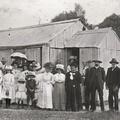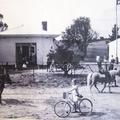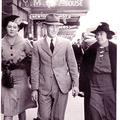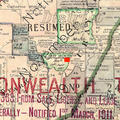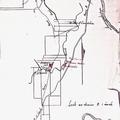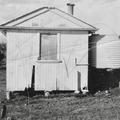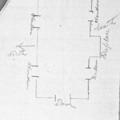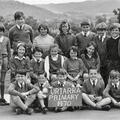< Early Canberra Government Schools
Uriarra School [1897 - 2001]
Early settlers in the district
Uriarra village and the surrounding sheep and cattle grazing district of Uriarra are near the Murrumbidgee River about 20 km west of Canberra. The area's first European occupation followed explorations of the Yass region in the 1820s. The name Uriarra (or Urayarra) is an Aboriginal term meaning either 'flat rock' or 'running to the feast' derived from a long-held practice of feasting on vast numbers of Bogong moths that congregated seasonally in the area. Mrs Eliza McDonald (1831-1917) recounted how Aboriginal people would gather locally in the early summer, collect large quantities of moths in the nearby hills and cook them on a big rock by the Murrumbidgee River, not far from the McDonald homestead on Uriarra station.
Eliza's father-in-law, Archibald McDonald, a Scottish immigrant, was the pioneering squatter of Uriarra station, which he named and settled on in the 1830s. Eliza was the first child of George Webb who had resided at Tidbinbilla before moving to Uriarra in 1864, onto a property he named 'Brookvale'. When George Webb died in 1891, his three sons were settled locally: the eldest George at 'Woodstock', William at adjoining 'Fairlight' and Joseph at 'Brookvale'. Their sister Eliza and her husband John McDonald resided nearby. Between them, the McDonald and Webb families occupied much of the Uriarra district in the mid to later 1800s (refer to the district map below).
Uriarra provisional school
Claire Lewis, in her book On the Back of Two Sheep: a history of George Soloman Webb and his family, pioneer settlers in the Tidbinbilly and Urayarra Runs (2012) pp 165-166, writes: -
'The desire for an education for their children led Joseph W McDonald, William McLaughlin, John McLaughlin and Michael Flanagan to submit an application on 22 October 1894 for a Provisional School at Uriarra. The Department of Public Instruction declined the application on 3 January 1895 as it was believed that there were insufficient children and that a Half-time or Home to Home school was impracticable.
'An undertaking had been given that the following children would attend the school: Gladys and Cedric McDonald; Eliza, Ernest and Herbert McLaughlin (children of John McLaughlin); Mary, Sarah, Eliza, William and Dina McLaughlin (children of William Mclaughlin); Catherine and Alfred Flanagan. Ten of the twelve were Catholics.
'A further application dated 8 October 1895 forwarded by Mr E.W. O'Sullivan to the Honourable J. Garrard requesting a Half-time school at Uriarra in partnership with Yumburra was also declined as was an application by William Webb, Joseph Blundell, Michael Flanagan and William McLaughlin dated 18 December 1895.'
Then in May 1896, the Department of Public Instruction received simultaneous requests from William McLaughlin, spokesperson for Uriarra parents, and Charles Walker, spokesperson for Ledgerton (20km north of Uriarra). As both districts had insufficient pupils to qualify for full-time schools, they requested that the Department consider opening two half-time schools - a common operation in small bush communities, whereby a single teacher conducted school half-weekly in two fairly close districts.
(For all Dept. of Educ. references: 'Uriarra School', 5/17949.2, 'Ledgerton School', 5/16574.2, NSW Archives)
The next month, Yass-based district inspector of schools, Patrick F Sheehy, visited both localities to attend to the matter. He reported that both places had the requisite pupil numbers to be half-time schools, and that the Uriarra parents had a disused church that could be made suitable for a schoolroom; Ledgerton parents, however, not having a schoolroom, would need to build one before the Department could consider their joint request.
When the Ledgerton representatives agreed to this, Inspector Sheehy had both groups complete formal applications. Uriarra's was signed by William McLaughlin, farmer & grazier; William Webb, farmer & grazier; Joseph McDonald, grazier; John McLaughlin, grazier; Michael Flanagan, selector; and Joseph Blundell, selector. The proposed schools were about 11 miles apart, and at Uriarra a teacher could be accommodated at William McLaughlin's residence on 'Woodside'. Uriarra's 16 pupils came from six families: William McLaughlin's children - Mary 14, Sarah 12, Eliza 10, William 8, Dina 6 and Margaret 4; Joseph McDonald's – Gladys 7, Cedric 5 and Edgar 3; John McLaughlin's – Eliza 11, Earnest 9 and Herbert 7; Michael Flanagan's – Catherine 11 and Alfred 6; Joseph Blundell's – William 6; William Webb's – Lottie 14.
In October 1896, Inspector Sheehy wrote to John McLaughlin seeking more information about the building they proposed converting to a school, in particular its dimensions, building materials, number of windows, fireplace for heating, toilet outhouses, etc. He also indicated that school furniture would be sent by rail, though the parents would be expected to contribute to its cartage from Queanbeyan to Uriarra. McLaughlin replied that it was a timber slab building with a galvanised roof, 22 x 12 feet in size. The walls were 7 feet high, had 5 windows, there was an open fireplace, a boarded floor and two outhouses. Additionally, McLaughlin provided a sketch of the floor plan (see below). The next month, having inspected the building, Sheehy reported that all was in order for the furniture to be sent: -
At Uriarra the schoolroom is the EC Church to which improvements have been effected to make it suitable for school purposes. The walls have been lined with T& G Pine, and a chimney and two outhouses have been built. I recommend that the Chief Clerk of Works be instructed to forward to Queanbeyan railway station, addressed to Mr John McLaughlin, Uriarra, 4 desks 7½ feet long 1 chair, 1 small table, I large and 4 small tablet boards for this school, and that a teacher be appointed immediately. The furniture will be conveyed from the railway station and fixed in the building free of cost by the residents. I have requested to have it sent at once, as a team from Uriarra will be in Queanbeyan on the 9th instant.
The first teacher, William Faulder
Appointed during the summer holidays, William Faulder opened the school in January 1897. Aged 27 and single, he was the youngest son of Thomas Faulder of Yass. While lodging at Charles and Annie Walker's residence at Ledgerton, he became romantically attracted to their 17-year-old daughter Isabella Ann (also known as Annie). Later in the year, when he applied to re-sit a teacher's examination he had just failed, Faulder explained to Inspector Sheehy that he wanted to improve his position, as a married man especially: -
Having failed my recent examination, I have the honour to request that you will recommend my application to be examined again in June 1898...
Further, I wish to mention that I am engaged to be married to Miss Walker of Ledgerton and have obtained this young lady's parents' consent to marry her. I have become ambitious, as it were, to improve my position and it would be a great disappointment if I were refused permission to be examined in June next.
If allowed to sit, I am determined to study assiduously and feel almost confident of success.
I have the honour...(etc) William Patrick Faulder, Teacher
When they married in January 1898, the couple moved into a cottage at Uriarra. The outcome of William's mid-year examination is not evident, however as they had a baby daughter at the end of that year, his promotion to a higher teaching salary would have been welcomed by them.
By then they were finding the Uriarra location unhealthily cold in winter. Before a second winter there, Faulder wrote to Inspector Sheehy applying to be transferred to a warmer district, to improve his own worsening health especially: -
... I am suffering with an affection to my lungs, and have been under medical treatment for the past eight months ... The climate of Uriarra is extremely cold in winter...(and) as the distance between the schools is about eleven miles, I have frequently to be out in wet weather and when there is a heavy fall of snow ... A repetition of this winter would cause me to get a relapse which, in my present state of health, would more than probably have a very serious result. I would prefer a full-time school situated in the Junee or Cootamundra districts, or in a warmer part of the Yass district, and within about 10 miles of a town so that I could obtain medical attention ... Mine is an extreme case and requires urgent attention, as it is only by taking the greatest care and attention that I can recover from the complaint with which I am suffering.
Twice in 1899, Inspector Sheehy recommended that Faulder's requested move be granted. In the meantime however, Faulder found much better accommodation near Ledgerton and withdrew his request to be moved. The residence they had moved into belonged to John Walker of 'Fairbank', who had vacated his home for a time after his wife died. As Faulder explained to Sheehy, he was now better placed to reach either school, being 2½ miles from Ledgerton and 8½ miles from Uriarra. His letter included a request that the Department pay his annual rent of ₤25, which was deemed acceptable and approved.
As customary in small bush schools, annual school picnics were usually a big event, involving the whole community. Uriarra's first picnic, held jointly with Ledgerton pupils in November 1897, was described as follows by the Queanbeyan Observer :-
About 40 children and 80 adults sat down to an excellent spread provided by the following ladies, viz., Mesdames Walker, Webb (2), Ledger, Buckmaster, Leonard, McDonald, Flanagan, McLaughlin and Blundell, and those ladies must be complimented for the kindly interest they displayed from the start to make the picnic the success it was. Prizes amounting to ₤8 were run off under the directorship of Messrs Faulder, Leonard, Walker, Webb, W McDonald and Morton McDonald while Miss Eliza Webb and Miss Walker distributed the prizes among the lucky winners. To these young ladies the credit of having collected and purchased the prizes must be given. During the afternoon, games etc., were indulged in and shortly after sundown cheers were given to the visitors and parents of the children and after they had been responded to by the teacher, a start was made for home, everyone entertaining happy recollections of the Ledgerton-Urayarra combined school picnic and expressing the hope that it may become an annual affair.
Contagious epidemics would occasionally sweep through a school, often infecting the teacher as well. On 27th April 1900, Faulder wrote to Inspector Sheehy about one such epidemic: -
I have the honour to inform you that, as Whooping Cough is now prevalent in the district, my little daughter, aged one year and six months has caught the infection. As it is impossible for me to isolate myself, I beg to apply for permission to close the Schools under my charge till the risk of conveying the infection to the scholars has passed. Please, reply, if possible, on Monday next, so as to enable me to receive it by Tuesday's mail.
The inspector recommended that Faulder be permitted to close his schools until the risk of contagion had passed, which was duly approved. The two schools were closed from 12th to 26th May - welcomed, no doubt, by pupils who hadn't succumbed to the sickness.
In October that year, Faulder was transferred to the half-time schools at Kangiara Creek and Tangmangaroo. He went on to have a long and successful teaching career before retiring to Goulburn where he died in 1947, in his 78th year. An obituary recorded that William Faulder 'had one of those quiet, charming and unassuming personalities which made him beloved of his scholars and held in the highest regard by the parents and his many friends'. (Trove: Picton Post, 6 March 1947)
Teacher John Adam
The next teacher, John Adam, was 22 when appointed to Ledgerton-Uriarra schools in November 1900. Being single, he was offered board by Charles and Annie Walker and soon became romantically attracted to their 19-year-old daughter Sarah Grace (known as Ruby) They were married on 19th December 1901 at the Presbyterian Church in Yass, and succeeded the Faulders in renting John Walker's residence at 'Fairbank'.
A problem arose in April 1903 when John Walker required the homestead for himself. Adam could find no similar accommodation and as the Department's lease was soon to expire, he requested to be transferred to another school with an attached residence as soon as possible. His long letter to Inspector Sheehy graphically illustrates the challenges many teachers experienced in remote bush schools, serving at half-time schools especially: -
I have the honour to forward herewith, notice to quit tenancy, which I have received from the owner of the house I am occupying. I am informed that he intends to remarry and requires his house as a residence for his wife and himself. ... I have tried by every means within my power to procure other accommodation in the district and have failed... I am classified 3A and have been in charge here for upwards of 3 years, having never had a vested residence. During my term here I have been under very heavy expense for fodder and carriage on life's necessities – the schools being extremely isolated.
The residence I am occupying is over 8 miles from Uriarra school and about 4 miles from Ledgerton school, and this compels me to be in the saddle every day over rough roads.
My wife has had to undergo hardships for a lady, in attending school for the tuition of sewing, over very bad roads and in all weathers. My present home is at least 2 miles from the nearest neighbours and the lonely life thus entailed on my wife and made worse by my daily absence, has under mined her health and made her exceedingly low spirited and melancholy, so much so that it is absolutely necessary for her to be in a place where she would not be so lonely ...
On account of Yass district being my wife's native place she would like a home somewhere in it. I, myself, would prefer a school in the Yass inspectorate. Failing a suitable vacancy in this inspectorate, I ask that I may be promoted to some charge situated within the coast district.
Inspector Sheehy gave Adam his full support, commenting that he was a capable, deserving teacher. In July 1903 he was appointed temporarily to Wargella public school, then transferred to Macquarie Street South school in Sydney. He went on to have a long and successful career, rising to school inspector in 1931.
A pupil's description of the school in 1904
[The school] is situated about two miles from the Murrumbidgee River, on the Uriarra Creek, a small affluent of that river. It is also about twenty-four miles from Queanbeyan, and about thirty-five miles south of Yass. When standing in the school grounds one can see for many a mile across the fertile pasture land to the north, to the east a view of about ten miles is obtainable, while to the south and west the rugged towering mountains conceal all from the eye of the spectator....
The playground is a very small one only, about half an acre. I suppose you would not call it a playground at all but out here there is very little need for a playground for we seldom have more than a dozen attending school at one time and if we do there is sufficient paddock room for a hundred. The playground is fenced in on three sides by a one-rail fence and two wires and on the northern side by a fence composed of one rail and five wires. The gate is on the western end facing the Government road which comes from Queanbeyan and goes on to Brindabella, Coolamon and Yarrangobilly Caves. There are three trees in the playground but they never seem to grow. When the school was built, which is about eight years ago, the ground was planted with trees but these three are the only ones which managed to live.
The school is built a little to the south of the centre of the ground and has one end toward the west and the other facing the rising sun. There are five windows in the school, two on each side and one in the eastern end. The walls are built of slabs and the roof is covered with galvanised iron.
At the southeast corner the tank is situated. It is a four hundred gallon ship tank and was set up about five years ago and has always plenty of water in it. The entrance to the school is at the western end and as the prevailing westerly winds used to cause no little inconvenience a porch has been erected to prevent the wind from blowing in at the door and that has made the school much more comfortable. Inside the school walls are lined with ½ in. pine but overhead it is not ceiled. The floor is laid with one inch pine boards. The school consists of one room and measures about twenty-two feet long by about twelve feet broad. The fireplace is on the south side.
The school furniture comprises four desks and an equal number of forms, one table and a chair, one blackboard and an easel with one broken leg. We have two maps, one of the world and one of Australia and also a picture of the reptiles of Australia and a picture of the tea-plant with the Oriental lady picking the tea leaves. Besides these we have books and slates and all the necessary requirements for carrying on a half-time school.
(School essay kept by former pupil Ernest McLaughlin, quoted in Claire Lewis, op.cit. p. 167)
Teacher John Coddington
Ledgerton-Uriarra was John T. Coddington's first appointment after finishing his pupil-teacher training in 1903. Aged 17 and on probation, his annual salary was ₤72. Like his predecessors, Coddington also became attracted to a local girl: Charlotte Annie Webb, the daughter of William and Jane Webb (nee Ledger) of 'Fairlight', Uriarra. They were married in April 1906, and took up residence near Charlotte's parents at Uriarra.
Like both teachers before him, Coddington found his working conditions increasingly difficult to cope with: the bleak winters at Uriarra and tiring travel in all kinds of weather exacting a heavy toll on his health. In 1907, after failing to obtain a transfer, he applied to resign, then on second thoughts changed his mind - as explained to a chief inspector in Sydney: -
I have the honour to inform you that... I do not wish to resign my position as teacher. If it is impossible to grant leave of absence, I would be contented with a removal to another school in a drier climate.
I have been stationed at these two half-time schools for nearly 4 years, and as it is a very wet and boggy place I have developed colds and rheumatism ... I trust you will not insist upon me resigning as when I was 3 years of age, I had the misfortune to lose my foot, which would render me incapable of performing hard labour, and furthermore my wife is almost out of her mind to think I will have to leave the Service.
Trusting you will appoint me to another school at Easter....
Due to insufficient pupils the two schools were closed that same Easter, so John Coddington obtained the transfer he had sought. He was moved to Burrumbuttock provisional school, near Albury, but soon left the teaching service, resigning six months later on 31st October 1907.
Uriarra subsidised school
The subsidised school scheme was first introduced in 1903 to assist isolated families who could not afford governesses. To obtain a subsidy of up to ₤25 per annum, two or more families had to engage a private teacher and provide the salary, lodging and a place to teach - the subsidy helping to defray their outlay. If enrolments stabilised sufficiently, a subsidised school could become, or return to, a public school - as did Uriarra; but more often they had a brief life, especially after correspondence education began in 1916. The other alternatives for parents were to engage private tuition from a governess or send their children to boarding schools.
Uriarra reopened as a subsidised school 1907-10, closed 1911-19, opened again 1920-26, then closed again for eight years. In this second life as a subsidised school, Uriarra's recorded history is fleeting. The subsidised teachers during 1907-10 were Edward Harris, Ivy Chinnery and Alice Mayo; during 1920-26, the teachers were Constance Quinn, Kathleen Crowe, EL Hanscombe, L Michell, and T White. One other glimpse of the school during these years is the following report of the school picnic held on Empire Day in May 1908: -
Uriarra: A picnic for the school children was held here on Empire Day, and as beautiful weather prevailed a most enjoyable time was spent by all present. The attendance was not as large as on previous occasions. Races for the children were run off during the day, the results being :-
Girls races: Georgina Gregory 1, Vera Phillips 2; Margaret Bryce 1, Mollie Hardy 2; Dorrie McDonald 1, Grace,McDonald 2; Mary Hardy 1, Beckie Perriott 2, Elsie Perriott 8; M. Bryce 1, Georgina McDonald 2, B Perriott 3. Boys races: G. Bryce 1. H. Bryce 2; Robert Patterson 1, Arnold McDonald 2; Bertie Phillips 1, Norman Blundell 2, H. Phillips 3; G. Bryce 1, A. McDonald 2, H. Bryce 3.
The prize fund was contributed to by the parents and friends of the children, and allowed of each child receiving a prize.
Edibles were provided in liberal quantities by the ladies, a number of whom saw to the welfare of those present.
Mr. John McLaughlin, who had taken a prominent part in the day's proceedings, expressed regret before dispersing, that Mr. John McDonald, who had been the initiator of the first picnic and had been prime mover on each separate occasion had been, through serious indisposition, unable to be present that day, and asked the children to show their appreciation of their patron's efforts by giving three hearty cheers, which were given, and the singing of a verse of the National Anthem and three cheers for the King, terminated the proceedings.
(Trove: Queanbeyan Age, 29 May 1908)
Uriarra public school, 1936-2001
In 1913-1915 a forestry camp was established at Uriarra for workers clearing eucalypt trees for the radiata pine plantations that formed the origins of the ACT plantation forest industry. Then in 1928 the Uriarra Forestry Settlement was established to permanently house forestry workers on the site, in a dual role as forestry workers and fire surveillance officers. The census for that year had 30 people residing at Uriarra Settlement.
In 1934 a subsidised school was opened, then in 1936 the Commonwealth Educational Department agreed to establish a provisional school in the area. Temporary accommodation was found in the old cottage that was once the Uriarra Post Office. The first students were from the families of Bourke, Bradley, Blundell, Skerry, McKenzie, Syphers and the Waldon's from Martins Corner. The school was known as the 'red school' because of its colour.
The 1936 school has been described as follows: 'typical of small rural schoolhouses from the early twentieth century, it is constructed of weatherboard, with a brick chimney and large pane sash windows, a hipped roof clad in corrugated iron and overhanging eaves. The building sits on stump footings to one side. The schoolhouse building contributes a discrete and picturesque element of historic character to the village, set back from the road'.
In September 1937 the school was relocated to its new premises within the Uriarra Forestry Settlement, with 16 students enrolled. By 1940 it had sufficient pupils to become a public school. In 1968, after the student numbers increased to 40, a second teacher was employed. A second school building was constructed in 1969, the original 1937 building being used as a pre-school from this time. In 2001 Uriarra School was permanently closed when its student numbers decreased to eight.
From the Canberra Times, 9 May 1968 - "Michael Dwyer ends his one-man rule":
The ACT still has farms, dirt roads and small settlements, but the rural character is changing. Today is probably the last on which a single-teacher school will be open in the Territory. From the beginning of next term Uriarra Primary School, 18 miles from Canberra, expects to have a second teacher and later in the year additions will be built so there will be two classrooms, an office and a television room next year.
Like Tharwa and Hall, which advanced from one-teacher status years ago, Uriarra has grown too big for one man to handle. Yesterday the one at Uriarra, Mr Michael Dwyer, had 34 youngsters - infants to 6th grade, ages five to 12 - on his hands. Next term he expects a roll of 42.
His own first schooling was at a country school near Blayney, NSW, and he enjoys teaching in country
schools. He admits it would be easier if he were married; a wife could help with typing and preparing teaching aids for the infants. She might also be able to help with teaching sewing.
Although he is struggling at times to teach so many in the one room, and he has to spend more hours in preparation than many primary teachers, Mr Dwyer says he has no desire to teach in Canberra. 'There's not much doing here socially, although two new tennis courts have helped a lot', he said. 'There's the occasional dance or housie evening for school funds — without the Parents and Citizens Association there wouldn't be any . . . This is a different small school in that it's part of the forestry village. It's a close settlement with all the children, except one, walking a few yards to school each day.
The school has been open since 1937 and until recently averaged about 15 pupils. One teacher liked it so much he was there for more than 20 years, living in a rather primitive-looking dwelling at the back.
Since 1942 there have been only three rural schools in the ACT, Hall, Tharwa and Uriarra. But as Canberra develops south and east the first two must enlarge further or be replaced. Only Uriarra is likely to maintain any rural character and setting for much longer.
From Canberra Times, April 1979
Uriarra Primary School, at Uriarra Forest, is unusual in that it has two teachers for 27 pupils. It is the only school in a radius of 19 kilometres and caters mainly for the children of forestry workers and farmers.
It is a small school, comprising two main teaching rooms. The principal, Mr Bob Bignill, teaches classes four, five and six, while Mrs Frances Dowling attends to students from kindergarten to class three. Although their respective responsibilities are 'very diverse', neither is daunted at the prospect of carrying out their duties, which are done with a view to enhancing the moral and social welfare of students.
'The education of the child is not confined to the four walls of a classroom as so much more can be achieved by getting to know the child and their family by continued contact in a great variety of situations', Mr Bignill said. 'The casual atmosphere of the playground, sportsfield, lunch sessions and so on can, and often do, create more educational opportunities than the classroom'.
'The school needs to be a happy place, physically conducive to learning', Mr Bignill continued.'The children need to be happy to learn and they must be treated as individuals. They must appreciate the fact that being in a small community requires co-operation and the ability to live in harmony. Respect and tolerance for the differing ideas and standards of other individual's needs to be maintained'.
In numeracy, a knowledge of the basic number facts and computations, with an emphasis on practical application, is the aim of the work. The reading program dominates the whole of the curriculum. Every opportunity is taken to consolidate skills and enhance enjoyment in literature. Anything the students do is done in small numbers. Craft and hobby activities include cooking, photography and woodwork. One acquisition of which the school is very proud is the video equipment, which was bought after a lot of 'scrimping and scraping' by teachers and students alike. With the help of the colour television, the video-cassette recorder and video camera, the students in the higher classes re-enact from history or drama.
Uriarra Primary was a one-teacher school from 1939 to 1969 operating from a single room. Ten years ago a second teacher was appointed after the new building was constructed. Active pupil involvement in school activities is encouraged, involving the school as a whole in making decisions is regarded as being of the utmost importance. Pupils, together with staff, are continually asked to express opinions and offer suggestions on running the school and planning excursions.
(Trove: Canberra Times, 15 April 1979)
From Canberra Times, June 1988
Each time Uriarra Primary School students visit a small paddock near their school they step back in time 100 years.
The tiny school (enrolment 27) and the local community in this small forestry settlement at the foot of the Brindabellas have taken over three abandoned huts formerly used by forestry workers. With the help of a grant from the Australian Bicentennial Authority they have turned what was a patch of rural slum, according to the school principal, Mr Rob Taylor, into a child's eye view of life in 1888.
The site is dominated by a tree-trunk flagpole, with a Union Jack borrowed from the British High Commission flying aloft. 'When we step through that gate, today's 31 May, 1888,' the school's other teacher, Ms Pam Pritchard, said yesterday. Last week the children celebrated Empire Day. Whenever she and her charges walk through the gate they take on the roles of people who actually lived in the district a century ago, and dress up accordingly. Ms Pritchard - the project is her brainchild - is Miss May Strong, an early tutor. The girls have their historic aliases embroidered on their frilly white aprons - old-fashioned names like Ethel, Kate, Eliza and Elsie.
There will be visits from a swagman and a gold prospector, a grand ball at the Yarralumla Woolshed and a traditional Christmas before the year is over. The three forestry huts have respectively become a craft hut, a storytelling hut and a kitchen hut where the roaring fire kept the billy boiling for morning tea yesterday.
Officially opened yesterday by the chief education officer of the ACT Schools Authority, Mr Eric Willmot, the project has already been visited by about 360 students from 'town'. Ms Pritchard hopes the authority will take it over permanently for school visits at the end of the year.
The Uriarra area, long a ceremonial meeting place for Aborigines, was settled by white people in the 1830s, and the Uriarra Station established in 1843. The first school started in 1897 in the local Anglican church, and a provisional school was established by the NSW Education Department in 1936.
(Trove: Canberra Times, 1 June 1988)
(Contributed by Keith Amos, former teacher at The Mullion, out of Yass)
Location Map
Related Photos
Teachers
- Faulder, Mr William Patrick
Half Time, 01/1897 - 10/1900 - Adam, John
Half Time, 10/1900 - 07/1903 - Coddington, John T.
Half Time, 07/1903 - 04/1907 - Smith, John James
11/1936 - 02/1940 - Browne, Mr Cecil P.
02/1940 - 1942 - Cornwall, Norman Spencer
02/1942 - 06/1942
01/1944 - 1963 - Shumack, John A.
01/1943 - 10/1943 - Allen, John K
01/1964 - 02/1965 - Porter, Kenneth
02/1965 - 02/1966 - Dwyer, Mr Michael
02/1966 - 11/1974
NSW Government schools from 1848
- Uriarra School (external link)
< Early Canberra Government Schools
If you are able to assist our work of identifying, documenting, and celebrating the early bush schools of the Canberra region, please contact us or .


